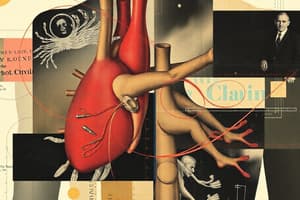Podcast
Questions and Answers
Which muscarinic receptor type is primarily involved in inhibitory actions in the heart?
Which muscarinic receptor type is primarily involved in inhibitory actions in the heart?
- M1
- Nicotinic
- M2 (correct)
- M3
What is the main effect of M3 receptor activation in the gastrointestinal tract?
What is the main effect of M3 receptor activation in the gastrointestinal tract?
- Inhibition of motility
- Increase in motility (correct)
- Relaxation of sphincters
- Decrease in secretion
Which of the following antagonists targets M1 receptors?
Which of the following antagonists targets M1 receptors?
- Atropine (correct)
- Glycopyrrolate (correct)
- Dopamine
- Nicotine
What secondary messenger is produced by M3 receptor activation in vascular smooth muscle?
What secondary messenger is produced by M3 receptor activation in vascular smooth muscle?
In the urinary tract, what effect do M3 receptors have on the bladder wall?
In the urinary tract, what effect do M3 receptors have on the bladder wall?
Which receptor type is primarily involved in excitatory functions in the CNS?
Which receptor type is primarily involved in excitatory functions in the CNS?
What is the effect of M3 receptor activation in the eye?
What is the effect of M3 receptor activation in the eye?
Which of these functions is NOT related to M3 receptor activation?
Which of these functions is NOT related to M3 receptor activation?
What is myasthenia gravis primarily characterized by?
What is myasthenia gravis primarily characterized by?
Which of the following is NOT a treatment option for myasthenia gravis?
Which of the following is NOT a treatment option for myasthenia gravis?
What may result from an excess intravenous injection of edrophonium?
What may result from an excess intravenous injection of edrophonium?
Which drug is described as a synthetic, quaternary amine used in myasthenia gravis treatment?
Which drug is described as a synthetic, quaternary amine used in myasthenia gravis treatment?
Which of the following adverse effects is associated with physostigmine?
Which of the following adverse effects is associated with physostigmine?
What is the effect of binding two acetylcholine molecules to its receptor?
What is the effect of binding two acetylcholine molecules to its receptor?
Which of the following is a reversible anticholinesterase?
Which of the following is a reversible anticholinesterase?
What is the duration of action of pyridostigmine?
What is the duration of action of pyridostigmine?
What is a characteristic of organophosphate compounds?
What is a characteristic of organophosphate compounds?
What is the main action of acetylcholine on the cardiovascular system?
What is the main action of acetylcholine on the cardiovascular system?
Which drug can penetrate the blood-brain barrier?
Which drug can penetrate the blood-brain barrier?
Carbachol has which of the following properties?
Carbachol has which of the following properties?
What occurs in the absence of administered cholinergic agents regarding vascular receptors?
What occurs in the absence of administered cholinergic agents regarding vascular receptors?
Which of the following statements about acetylcholine is true?
Which of the following statements about acetylcholine is true?
Which of the following is NOT an effect of acetylcholine on the eye?
Which of the following is NOT an effect of acetylcholine on the eye?
What is the key mechanism by which acetylcholine causes vasodilation?
What is the key mechanism by which acetylcholine causes vasodilation?
What is the primary therapeutic use of carbachol?
What is the primary therapeutic use of carbachol?
What distinguishes bethanechol from acetylcholine regarding its metabolism?
What distinguishes bethanechol from acetylcholine regarding its metabolism?
Which of the following is a common adverse effect of bethanechol?
Which of the following is a common adverse effect of bethanechol?
What is the effect of pilocarpine on the eye?
What is the effect of pilocarpine on the eye?
Which condition is bethanechol primarily used to treat?
Which condition is bethanechol primarily used to treat?
What type of action does carbachol exhibit in the nervous system?
What type of action does carbachol exhibit in the nervous system?
Which statement about pilocarpine is correct?
Which statement about pilocarpine is correct?
How does carbachol affect intraocular pressure?
How does carbachol affect intraocular pressure?
What effect do cholinomimetics have on closed angle glaucoma?
What effect do cholinomimetics have on closed angle glaucoma?
Which condition is Cevimeline primarily used to treat?
Which condition is Cevimeline primarily used to treat?
What side effect is associated with direct acting parasympathomimetics?
What side effect is associated with direct acting parasympathomimetics?
Which of the following is classified as a reversible indirect-acting cholinergic agonist?
Which of the following is classified as a reversible indirect-acting cholinergic agonist?
What is a primary action of indirect acting cholinergic agonists?
What is a primary action of indirect acting cholinergic agonists?
What is the duration of action for Edrophonium as an AChE inhibitor?
What is the duration of action for Edrophonium as an AChE inhibitor?
Which of the following side effects is NOT commonly associated with direct-acting parasympathomimetics?
Which of the following side effects is NOT commonly associated with direct-acting parasympathomimetics?
What type of agent are organophosphates considered in relation to cholinergic activity?
What type of agent are organophosphates considered in relation to cholinergic activity?
What are the origins of the sympathetic and parasympathetic nervous systems?
What are the origins of the sympathetic and parasympathetic nervous systems?
Which enzyme is responsible for the synthesis of acetylcholine in cholinergic neurons?
Which enzyme is responsible for the synthesis of acetylcholine in cholinergic neurons?
Which receptors primarily bind to acetylcholine in the central and peripheral nervous systems?
Which receptors primarily bind to acetylcholine in the central and peripheral nervous systems?
What is the mechanism of action for the termination of acetylcholine's function?
What is the mechanism of action for the termination of acetylcholine's function?
Which parasympathetic pre-ganglionic fiber characteristic distinguishes it from sympathetic fibers?
Which parasympathetic pre-ganglionic fiber characteristic distinguishes it from sympathetic fibers?
Which of the following subclasses of muscarinic receptors is present in the CNS?
Which of the following subclasses of muscarinic receptors is present in the CNS?
What role does acetyl coenzyme A play in acetylcholine synthesis?
What role does acetyl coenzyme A play in acetylcholine synthesis?
Which statement correctly differentiates between the lengths of post-ganglionic fibers in the sympathetic and parasympathetic systems?
Which statement correctly differentiates between the lengths of post-ganglionic fibers in the sympathetic and parasympathetic systems?
Flashcards
Muscarinic Receptors
Muscarinic Receptors
A family of acetylcholine receptors coupled to G proteins and are activated by muscarine, a substance derived from the mushroom Amanita muscaria.
M1 Receptor
M1 Receptor
A major type of muscarinic receptor coupled to Gq protein, found in the CNS, gastric parietal cells, salivary glands, and smooth muscle.
M2 Receptor
M2 Receptor
A type of muscarinic receptor coupled to Gi protein, predominantly found in cardiac muscle, smooth muscles, and also plays a role in reducing heart rate.
M3 Receptor
M3 Receptor
Signup and view all the flashcards
Nicotinic Receptors
Nicotinic Receptors
Signup and view all the flashcards
Neuromuscular Transmission
Neuromuscular Transmission
Signup and view all the flashcards
Muscarinic Blocker
Muscarinic Blocker
Signup and view all the flashcards
Cholinergic actions
Cholinergic actions
Signup and view all the flashcards
Cholinergic Neuron
Cholinergic Neuron
Signup and view all the flashcards
Cholinergic Receptors
Cholinergic Receptors
Signup and view all the flashcards
Acetylcholine Synthesis
Acetylcholine Synthesis
Signup and view all the flashcards
Acetylcholine Storage and Release
Acetylcholine Storage and Release
Signup and view all the flashcards
Acetylcholine Action
Acetylcholine Action
Signup and view all the flashcards
Acetylcholine Degradation
Acetylcholine Degradation
Signup and view all the flashcards
Cholinomimetics
Cholinomimetics
Signup and view all the flashcards
Cholinomimetics in Glaucoma
Cholinomimetics in Glaucoma
Signup and view all the flashcards
Cevimeline
Cevimeline
Signup and view all the flashcards
Anticholinesterases
Anticholinesterases
Signup and view all the flashcards
Edrophonium
Edrophonium
Signup and view all the flashcards
Acetylcholinesterase (AChE)
Acetylcholinesterase (AChE)
Signup and view all the flashcards
Effects of AChE Inhibition
Effects of AChE Inhibition
Signup and view all the flashcards
Organophosphates
Organophosphates
Signup and view all the flashcards
What is Myasthenia Gravis?
What is Myasthenia Gravis?
Signup and view all the flashcards
What are indirect-acting cholinergic agonists (anticholinesterases)?
What are indirect-acting cholinergic agonists (anticholinesterases)?
Signup and view all the flashcards
What is Physostigmine?
What is Physostigmine?
Signup and view all the flashcards
What is Neostigmine?
What is Neostigmine?
Signup and view all the flashcards
What is Pyridostigmine?
What is Pyridostigmine?
Signup and view all the flashcards
What are organophosphates?
What are organophosphates?
Signup and view all the flashcards
What is Echothiophate?
What is Echothiophate?
Signup and view all the flashcards
What is a cholinergic crisis?
What is a cholinergic crisis?
Signup and view all the flashcards
What are the two main subtypes of acetylcholine receptors and where are they located?
What are the two main subtypes of acetylcholine receptors and where are they located?
Signup and view all the flashcards
How do nicotinic receptors work?
How do nicotinic receptors work?
Signup and view all the flashcards
What are the functions of muscarinic receptors?
What are the functions of muscarinic receptors?
Signup and view all the flashcards
How does nicotine affect nicotinic receptors?
How does nicotine affect nicotinic receptors?
Signup and view all the flashcards
What are direct-acting parasympathomimetics?
What are direct-acting parasympathomimetics?
Signup and view all the flashcards
What are indirect-acting parasympathomimetics?
What are indirect-acting parasympathomimetics?
Signup and view all the flashcards
What is acetylcholine and how does it act?
What is acetylcholine and how does it act?
Signup and view all the flashcards
What is carbachol?
What is carbachol?
Signup and view all the flashcards
What is Carbachol and its main function?
What is Carbachol and its main function?
Signup and view all the flashcards
Why is Carbachol rarely used therapeutically?
Why is Carbachol rarely used therapeutically?
Signup and view all the flashcards
What is Bethanechol and what are its therapeutic uses?
What is Bethanechol and what are its therapeutic uses?
Signup and view all the flashcards
How does Bethanechol differ from acetylcholine?
How does Bethanechol differ from acetylcholine?
Signup and view all the flashcards
What is Pilocarpine and its primary therapeutic uses?
What is Pilocarpine and its primary therapeutic uses?
Signup and view all the flashcards
What are the potential side effects of Pilocarpine?
What are the potential side effects of Pilocarpine?
Signup and view all the flashcards
How does Pilocarpine lower intraocular pressure?
How does Pilocarpine lower intraocular pressure?
Signup and view all the flashcards
Explain the key characteristics and actions of Pilocarpine.
Explain the key characteristics and actions of Pilocarpine.
Signup and view all the flashcards
Study Notes
Cholinergic Agonists Overview
- The lecture covers pharmacology of drugs acting on the autonomic nervous system and autacoids.
- It includes topics on pharmacological actions, side effects, drug interactions, and uses.
- The lecture notes cover data from basic sciences to address therapeutic issues.
- Learning objectives include selecting appropriate pharmacotherapeutic approaches based on etiology, pathophysiology, laboratory diagnosis, and clinical features.
- Recognizing pharmacological properties of diverse drugs is also a learning objective.
Parasympathetic vs. Sympathetic
- Sympathetic: Originates in thoraco-lumbar segments, has short preganglionic fibers and long postganglionic fibers.
- Parasympathetic: Originates in cranio-sacral segments, has long preganglionic fibers and short postganglionic fibers.
Cholinergic Neurotransmission
- Acetylcholine (ACh) synthesis occurs in cholinergic nerve terminals.
- Acetylcholine is formed via acetylation of choline by choline acetyltransferase (ChAT).
- Acetyl Coenzyme A (acetyl donor) and choline are required; choline is provided from high-affinity uptake after ACh hydrolysis and phospholipid hydrolysis within the neuron.
- ACh is transported to vesicles and released by exocytosis to bind to muscarinic or nicotinic receptors.
- Acetylcholinesterase (AChE) terminates ACh action by hydrolyzing it into acetic acid and choline. More than 50% of choline is recycled for ACh synthesis.
Cholinergic Receptors
- Muscarinic receptors: G protein-coupled (metabotropic) receptors.
- Bind to acetylcholine and muscarine, with weaker affinity to nicotine.
- Five subtypes (M1, M2, M3, M4, and M5).
- M1, M2 and M3 are found peripherally and centrally and M4, M5 present only centrally.
- Receptor activation leads to different intracellular responses.
- M1: IP3, DAG pathway.
- M2: cAMP pathway (inhibition).
- M3: IP3, DAG pathway.
- Nicotinic receptors: Ligand-gated ion channels (ionotropic receptors).
- Bind to acetylcholine and nicotine.
- Show weak affinity to muscarine.
- Binding of two acetylcholine molecules causes a conformational change allowing sodium ions entry.
Cholinergic Actions and Receptors
- Heart: M2 receptors result in negative inotropic and chronotropic effects.
- Vascular smooth muscle: M3 receptors activate nitric oxide production causing vasodilation.
- GIT: M1 and M3 receptors regulate secretion and motility
- Urinary Tract: M3 receptors contract sphincter and bladder wall.
- Eye: M3 receptors cause miosis (pupil constriction) and accommodate near vision.
- Bronchi: M3 receptors cause constriction.
Direct Acting Parasympathomimetics
- Acetylcholine (ACh): Quaternary ammonium, cannot penetrate membranes, and inactivated by cholinesterase, has both muscarinic and nicotinic activities, of no therapeutic significance.
- 2-Carbachol: Muscarinic and nicotinic activity, mimics ACh effects on CVS, GIT, and eye (miosis), a poor substrate for acetylcholinesterase. Also, used to treat glaucoma by decreasing intraocular pressure. Has less adverse effects ophthalmologically.
- 3-Bethanechol: Structurally related to ACh, not hydrolyzed by acetylcholinesterase, has strong muscarinic activity, primarily acting on the GIT and bladder, is used for atonic bladder, neurogenic atony, and megacolon. Adverse effects include sweating, salivation, flushing, hypotension, abdominal pain, and diarrhea.
- 4-Pilocarpine: Tertiary amine, stable to acetylcholinesterase, less potent than acetylcholine, enters the CNS at therapeutic doses, shows muscarinic activity, used in glaucoma treatment, and causes miosis, and increased secretions of sweat, tears, and saliva. Adverse effects include CNS side effects and sweating/salivation.
- 5-Cevimeline: Selective M3 agonist, used to treat xerostomia and Sjogren's syndrome, has fewer adverse effects than pilocarpine.
Indirect Acting Parasympathomimetics: Anticholinesterases
- 1-Edrophonium: Prototype short-acting acetylcholinesterase (AChE) inhibitor, used for diagnosing myasthenia gravis, with a short duration of action (10-20 minutes).
- 2-Physostigmine: Naturally occurring tertiary amine, intermediate-acting AChE inhibitor stimulating M and N receptors and able to cross the BBB.
- 3-Neostigmine: Synthetic quaternary amine, intermediate-acting AChE inhibitor with more skeletal muscle effects compared to physostigmine, not crossing the BBB, used in myasthenia gravis treatment and antidote for competitive neuro-muscular blocking agents like tubocurarine.
- 4-Pyridostigmine: Similar to Neostigmine but has a longer duration of action (3-6 hours).
- 5-Organophosphates: Covalently bind to AChE, extremely stable and require enzyme synthesis to recover, toxic insecticides (e.g., parathion, malathion) and nerve agents (e.g., sarin), treated with pralidoxime.
Additional Information
- Myasthenia Gravis: An autoimmune disease impacting the skeletal muscle, characterized by antibody binding to nicotinic receptors in the neuromuscular junction (NMJ), leading to muscle weakness, involving eye, face and limb muscles. Treated with immunosuppressant drugs, neostigmine (a cholinesterase inhibitor that inhibits the breakdown of acetylcholine, thus increasing its action), or surgical removal of the thymus gland.
- Cholinergic Crisis: Excess cholinergic stimulation producing adverse symptoms such as diarrhea, urination, miosis, and bradycardia.
Studying That Suits You
Use AI to generate personalized quizzes and flashcards to suit your learning preferences.





